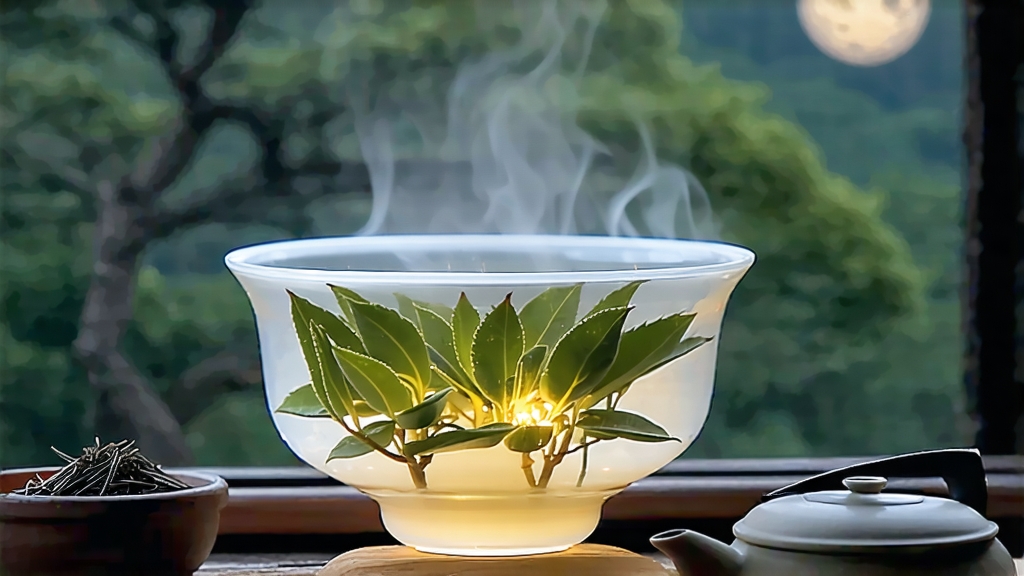
Tucked high on the forested ridges of southern Yunnan, where the Mekong bends like liquid silver and morning mists linger until noon, a tea is made that looks as if the moon itself left a fingerprint on every leaf. International traders sometimes call it “Moonlight White,” while local Dai and Hani people simply say “yue guang bai”—the white of moonlight. Unlike the better-known Fujian white teas such as Silver Needle or White Peony, Moonlight White is a relative newcomer to the Chinese tea canon, yet it carries centuries of Yunnan’s tea wisdom in its DNA. This article invites you to step into that mountain moonlight, to understand how a large-leaf Assamica cultivar can be coaxed into the most delicate of white teas, and to learn how to brew, taste, and treasure it like a seasoned tea traveler.
-
Origins and legend
The first documented batches of Moonlight White appeared in Lincang and Simao prefectures during the mid-1990s, when innovative producers began experimenting with white-style processing on the region’s ancient tea trees. A romantic story quickly took root: pickers would harvest only on clear nights when the moon was full, believing that cool lunar rays reduced bitterness and drew sweetness into the leaf. While modern makers now pick at dawn to capture optimal leaf turgor, the legend persists, and many factories still wither leaves under open skylights where moonlight can “kiss” the tea. The name thus bridges myth and marketing, but the flavor justifies the poetry. -
Botanical lineage
Moonlight White is crafted from Yunnan’s endemic Da Ye Zhong (large-leaf) variety, Camellia sinensis var. assamica. These trees, often 200–800 years old, grow at 1,200–2,000 m elevation in biodiverse forests. The leaves are unusually broad and thick, rich in polyphenols and amino acids, yielding a tea that is simultaneously weighty and ethereal. Because the raw material contains more soluble sugars than Fujian’s small-leaf cultivars, Moonlight White can withstand longer withering without becoming grassy, developing instead a honeyed, muscatel depth. -
Plucking standard
Only the terminal bud and the adjacent two leaves are taken. The ideal plucking moment is when the dew has lifted but before the sun grows hot, ensuring minimal mechanical damage and maximum enzymatic activity. Experienced pickers look for a faint purple rim on the bud’s underside—an indicator of high anthocyanin content that will oxidize into burgundy streaks during processing. -
Crafting moonlight: the eight silent steps
a. Outdoor withering: trays of leaves are laid on bamboo racks inside screened courtyards where mountain breezes lower moisture from 78 % to roughly 55 % over 24–36 h. Temperature is kept below 28 °C to prevent premature red edges.
b. Indoor wilting: leaf piles are moved to dimly lit rooms for another 12–18 h. Here the “three transformations” occur—grassy notes fade, floral precursors intensify, and a silver down becomes prominent on the bud.
c. Gentle oxidation: unlike green tea’s kill-green step, white tea relies on residual enzymes. Masters turn the leaf every hour to ensure even oxygen contact, watching for a color shift from jade to ebony on the upper surface while the underside remains pale—hence the distinctive two-tone leaf.
d. Shade drying: when the leaf feels cool and limp, it is transferred to loft dryers where warm air (35–40 °C) circulates for 4–6 h. No direct sunlight is allowed, preserving the crescent-moon pallor.
e. Rest and respiration: finished maocha is bagged in linen and left to “sleep” for 7–10 days so internal moisture equalizes; this step reduces astringency.
f. Final sorting: buds longer than 2.5 cm are graded as “Needle of Night,” while open leaves become “Moonlight Peony.” Stems and broken pieces are diverted to cake-pressed versions.
g. Optional compression: some producers steam and stone-press the tea into 100 g cakes, believing that slow aging deepens maltiness.
h. UV sterilization: a low-dose UV pass eliminates surface microbes without heat, ensuring